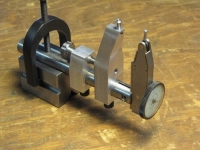¨The sagitta, ED (marked S in the diagram) is the distance from the chord to the circle's circumference¨
Marv, in your diagram, the sagitta, marked S is the line segment EC, not ED (ED is half the chord BD, not the sagitta). Too lazy to check the rest of the math (too late, too much wine), so assume r and d expressions - and results correct within YMMV.


 LinkBack URL
LinkBack URL About LinkBacks
About LinkBacks


 Reply With Quote
Reply With Quote




















Bookmarks